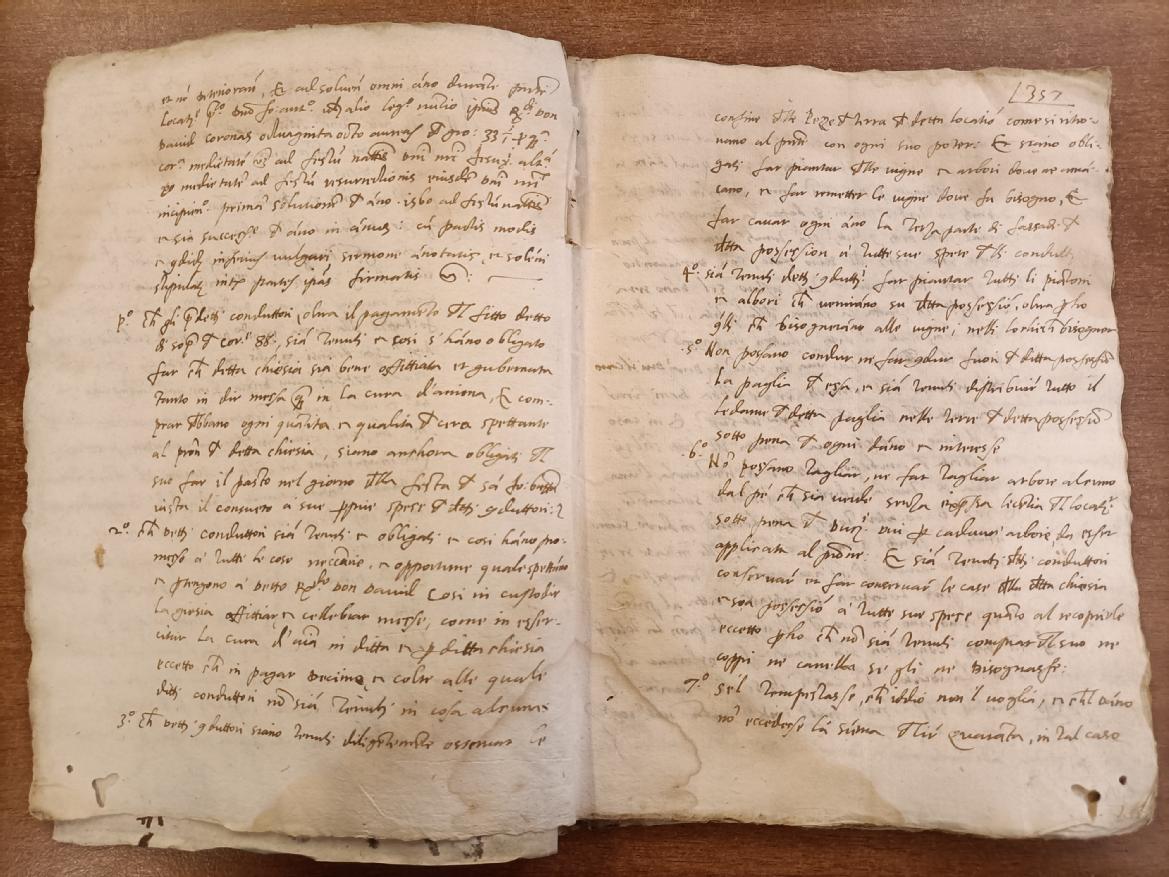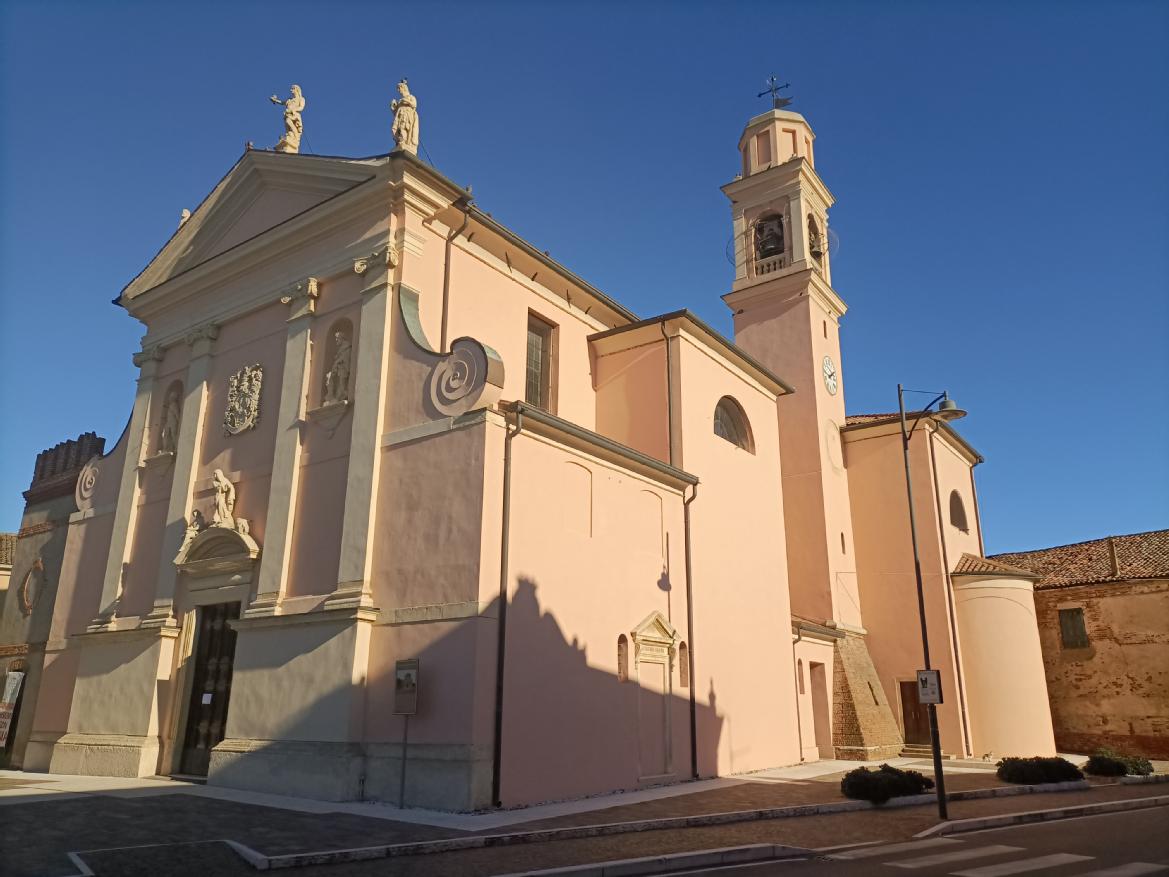The Impact of the Counter-Reformation on Parish Feasts in Northern Italy
Mattia Corso (Roma Tre)
In early modern Europe, the feast day of the patron saint was a central event in the life of religious communities.[1] This type of celebration, which fell on a day fixed in accordance with the liturgical calendar, was called sagra in Italy. Having a celestial protector was a substantial commitment; it required communities to devote economic resources to the construction and maintenance of places of worship. During the day of the sagra, vows obliged members of the parish community to abstain from work and all productive activities. As a norm, these pacts were certified by a notary and registered as formal laws in local statute books. Ordinances and decrees ensured that at least one member of each household participated in religious services, under the threat of a fine. Observances began the day before with an evening service and included a main sung mass the following morning, often accompanied by a procession and a series of low masses. Groups of devotees, organised in confraternities, played an active role in the preparation and practical celebration of the rituals in honour of the saint.
Despite their significant role in shaping religious experience, sagre have not yet received extensive scholarly attention within the historiography of Italian Catholicism. One of the aspects waiting to be explored is the practice of sharing food among members of the parish community and religious guilds. As we shall see, communal meals were an integral part of the annual feast of the patron saint. The importance that communities attributed to these convivial gatherings left its mark on the local economy, as a significant proportion of resources was devoted to the food and drink consumed in honour of the saints. In this post, I will present selected findings on sagre, drawn from the documentation of rural parishes in sixteenth-century northern Italy. This strand of research was part of my doctoral thesis, which used a microhistorical approach to examine the complex processes that the transition from pre- to post-Tridentine Catholicism entailed at the local level.[2]
Traces of the custom of using parish funds to finance the communal distribution of food and drink at major religious festivals are documented in the contracts formalising the transfer of ecclesiastical benefices, where the provision of a communal meal is often listed as one of the parish priest's obligations to his flock. A good example of this is the notarial deed of 1559, by which the pastoral care of the church of San Giovanni Battista in Cucca [now Veronella], a village in the diocese of Vicenza, was entrusted to a new parish priest (Figure 1). In the first clause of the contract, it was clearly stated that Don Prosdocimo was obliged, as part of his pastoral duties, to provide a meal on the day of San Giovanni Battista, in accordance with the customs of the village.[3] The same obligation applied to village priests of other dioceses. In the Bishopric of Verona, the parsons of Ronco, Brentino, Cogollo and Arbizzano, among others, were responsible for feeding the community, or as we shall see, at least its representative members, on the feast of the patron saint.[4] Depending on the local balance of rights and duties that was specific to each parish, the provision of a meal in honour of the patron saint could be considered one of the customary obligations of the parish priest to his community, as the case of the parish of Briana, a village between Padua and Treviso, demonstrates. A copy of the agreement for his salary drawn up in 1534 lists the cost for the feast alongside the expenses for ritual objects, such as candles and the olive branches that the priest blessed and distributed among the congregation on Palm Sunday. Numerous such expenses were thus deducted from the priest's annual salary, which in Briana consisted of more than eight hundred kilos of wheat, three cartloads of hay and the modest sum of two lire.[5]

Fig. 1 The notarial deed issued by the notary Paolo Soprana, certifying the assignment of the ecclesiastical
benefice of the church of San Giovanni Battista in Cucca to Prosdocimo Dalla Corte. Reproduced with kind
permission of the State Archive of Verona, Protocollo N. 3355 cl. 28.10.13/80/2023 (17.10.2023).
Due to limited resources, participation in the banquets dedicated to the celestial protectors was probably reserved for selected members of the community. In Ronco, for example, where the feast was celebrated on the day of the Virgin's birth, annually on 8 September, only the heads of families were allowed to attend.[6] This restriction served various purposes. On the one hand, limiting access to a certain number of guests naturally reduced the resources required to prepare the banquet. On the other hand, by giving a place at the table to the heads of the families, the meal functioned as a social ritual, strengthening the bond between the community, embodied by its most representative members, and the divine.[7]
Moreover, the limited number of guests ensured a richer and more refined fare. This was especially the case when the meal was organised by a religious guild. The confraternity of Santa Cristina del Tiverone, located in what is now Quinto di Treviso, for instance, celebrated its patron saint by eating bread with an impressive range of boiled and roasted meats.[8] Each December, as part of the celebration of the Feast of the Conception of the Virgin, the confraternity of the Madonna in Martellago feasted on a whole ox, while in November, the confraternity of the Body of Christ in Villamarzana relished a meal prepared with pork and cabbage.[9] In a village in the foothills outside Verona called Fumane, a religious guild known as the Convivium held a banquet consisting of veal, wheat bread and a peppery soup for San Martino (11 November). As required by their statutes, food for their annual banquet had to be of the finest quality. Eight days before the feast, the heads of the families sponsoring the meal had to donate seventeen litres of wine each, resulting in the collection of more than five hundred litres of wine.[10] These opulent banquets were often hosted in dedicated spaces attached to the oratories and chapels of the confraternities, as exemplified in Porto di Legnago, where the confraternity of San Giovanni maintained a room called the “Cenacle”.[11] As the case of Fumane shows, the members of the confraternities provided the resources for the guild banquets themselves, in accordance with their own statutes. In order to meet the demand for more expensive ingredients, sometimes an additional fee was required by decree. For instance, the members of the confraternity of San Nicola of Villa del Bosco had to reach into their pockets if they wanted to include meat in their annual meal.[12] Interestingly, in Scorzè the women of the confraternity of the Battuti were responsible for collecting the additional amount, revealing new aspects of the role of women as active members of religious guilds. This task was carried out on the morning of the feast, when the women of the confraternity went from house to house singing and carrying the banner portraying the Madonna and San Benedetto. Every member was asked for the thirty soldi, that were due for the sumptuous feast of pork and ox, bread and peverada, a spiced soup.[13]
Much of the information on the festive meals comes from the records of the episcopal visitations carried out in the last decades of the sixteenth century. It was during this period that the feasts in honour of the saints began to be seen as unnecessary and harmful customs, diverting precious funds from the reforms of the parish churches advocated for by the Council of Trent (1545-1563). Instead of buying and cooking meat and vegetables for an annual event, local resources would be better used for the more permanent cause of renovating places of worship. This was the message that several bishops gave to the communities. In Treviso, between 1564 and 1577, Bishop Giorgio Corner frequently ordered the suspension of these meals. The respective funds were redirected to the purchase of new altar furnishings, including banners and paintings.[14] Bishop Michele Priuli implemented similar measures during his pastoral visit to the diocese of Vicenza in 1580. In Cucca (Figure 2), as well as in other villages, episcopal decrees diverted the funds spent on communal meals to more "pious purposes".[15] As well as channelling the use of parish funds to what the ecclesiastical authorities considered to be more useful purposes, the abolition of patron saint's feasts also aimed to establish a clear boundary between sacred and secular spaces and the behaviour associated with them. Severe penalties were imposed, when the use of sacred spaces for banquets came to the attention of the episcopal authorities, as in the case of Porto di Legnago, where – as we have seen above - the confraternity of San Giovanni maintained a dedicated venue and, in 1605, was threatened with the temporary closure of the church.[16] This campaign against the consumption of resources for patronal feasts launched by the bishops of northern Italy could thus be placed within the wider process of the reform of popular culture famously described by Peter Burke. "The idea that festivals were a waste of money was a recurrent one" among the reformers, Burke argued.[17]

Fig. 2 The parish church of Cucca [now Veronella]. Picture by the author.
Yet, in the face of reform efforts, many communities responded with opposition and resistance. The people of Brebbia and Albusciago, both under the Archdiocese of Milan, protested against the abolition of the meals owed by their parish priests by withholding the payment of their ecclesiastical dues.[18] The first fruits of the harvest were no longer delivered to the churches after the ban on customary meals changed the terms of existing agreements.[19] In fact, the same type of reaction could already be observed in the diocese of Verona during the episcopate of the influential pre-Tridentine reformer Gian Matteo Giberti (1524-1543). In Malcesine, in 1541, his proposal to redirect the funds traditionally allocated to the meal to more useful purposes was rejected on the grounds that if this was the bishop's will, then the tithe on wine should also be lifted.[20]
In conclusion, episcopal attempts to eradicate parish banquets not only affected the way people negotiated their relationship with the divine by sharing food and drink in a social ritual in honour of their patron saint. They also interfered with the way in which local communities had traditionally mobilised their economic resources for religious life. The changes to local customs demanded by the episcopal authorities were in some cases rebuffed; a form of local resistance to ecclesiastical intervention in the socio-economic foundations of devotional life, that was also observed in other parts of Europe.[21] The administration of parish resources for patron saint feasts thus provides a valuable lens through which the emergence of social and political tensions can be examined at a local level in the wake of the Catholic Church's attempts to implement the reforms outlined by the Council of Trent.
BIOGRAPHICAL NOTE

Mattia Corso is a research fellow at the Department of Political Science of the University of Roma Tre, as a member of the ERC HOLYLAB project, directed by Prof. Felicita Tramontana. His research interests focus on the history of religion and material culture.
[1] Muir E., Ritual in Early Modern Europe (Cambridge, 1997).
[2] Corso M., Luoghi, riti, società. Antropologia della pratica religiosa della Terraferma veneta del XVI secolo, unpublished DPhil thesis, University of Padua (2020).
[3] State Archive of Verona, Archivio notarile, Atti Notaio Paolo Soprana, b. 9812, prot. 10, ff. 356v-357r.
[4] Fasani, A. (ed.), Riforma pretridentina della Diocesi di Verona. Visite pastorali del vescovo G. M. Giberti 1525-1542, 3 vols. (Vicenza, 1989), vol. i, pp. 80-81; ibid., vol. ii, pp. 570, 1007. Archivio Storico della Curia Diocesana di Verona (ed.), Agostino Valier. Visite Pastorali a chiese della diocesi di Verona, anni 1565-1589. Trascrizioni dei Registri XIII-XIV delle Visite Pastorali (Verona, 2001) pp. 36-37.
[5] Historical Archive of Noale, Volume Reggimento, b. 76, f. 1330r.
[6] Fasani (ed.), Riforma pretridentina della Diocesi di Verona, vol. i, pp. 80.
[7] On this aspect cf. Torre A., Production of Locality in the Early Modern Ages: Places (Abingdon, 2019), pp. 21-43.
[8] Agnoletti C., Treviso e le sue pievi, 2 vols. (Treviso, 1897), vol. i, p. 604.
[9] Liberali G., La diocesi delle visite pastorali, 2 vols. (Treviso, 1976-1977), vol. i, p. 118; Historical archives of Diocese of Rovigo, Visite pastorali, b. 3, Quinternus visitae anni MDLVIII, ff. 34v-35r.
[10] Cipriani M., Il Convivium di Fumane (1449): un'esperienza di solidarietà comunitaria, «Annuario storico della Valpolicella», vol. 19 (2002/03) pp. 207-240.
[11] State Archive of Verona, Commenda di San Vitale e Santo Sepolcro, processi, b. 14, n. 267, f. 5r.
[12] Public Library of Padua, B. P. 1419, f. 10r.
[13] Liberali, La diocesi delle visite pastorali, vol. i, p. 114.
[14] Liberali, La diocesi delle visite pastorali, vol. i, p. 124; vol. ii, p. 378.
[15] Historical archives of Diocese of Vicenza, Visite pastorali, b. 4 A – 0556. The photocopied version of the documents I was allowed to examine had no page numbers in the case of Cucca. For a similar order see ff. 92v-93r.
[16] State Archive of Verona, Commenda di San Vitale e Santo Sepolcro, processi, b. 14, n. 267, f. 5r.
[17] Burke P., Popular Culture in Early Modern Europe (Farnham, 2009), p. 296.
[18] Turchini A. (ed.), Monumenta borromaica, vol. 2, Milano inquisita. Inchieste di Carlo Borromeo sulla città e diocesi. 1574-1584 (Cesena, 2010), pp. 176, 178.
[19] The local community's ownership of tithes and their use to finance food-sharing practices has been the focus of a recent study by Massimo Della Misericordia, 'In pane pro caritate. Decime, comuni e poveri nella montagna lombarda (secoli XIV-XVI)', in Benito P., Carocci S., Feller L. (eds), Économies de la pauvreté au Moyen Âge (Madrid, 2023), pp. 293-310.
[20] Fasani (ed.), Riforma pretridentina della Diocesi di Verona, vol. iii, pp. 1390-1391.
[21] See Forster M., The Counter-Reformation in the Villages Religion and Reform in the Bishopric of Speyer, 1560-1720 (Ithaca 1992).
